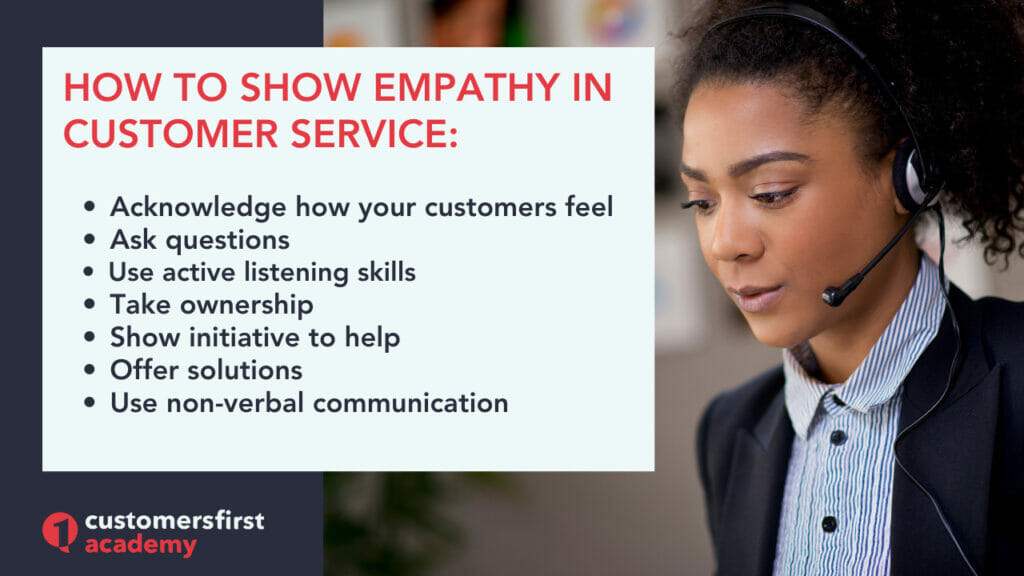Your customers are people, too. They want to be understood. They want to be heard. And if something goes wrong, they need someone to listen, understand, and help them.
Learning how to express empathy in customer service is important to make sure your customers feel respected.
Empathy can be expressed through words or actions. Both are equally important when trying to create a connection. It doesn’t matter what industry you work in. If you are in a customer-facing role, how you communicate with your customers is incredibly important.

How to express empathy in words
We know how important it is for businesses to connect with their customers on an emotional level. After all, without customers, businesses wouldn’t be able to succeed.
Assuming that you work directly with customers, how do you express empathy in words? Here are a few techniques that you can apply to succeed on the job!
1. Acknowledge how your customers feel
Acknowledging how your customers feel is one of the best ways to express empathy. No matter how upset the customer is, acknowledging their feelings can make a big difference.
Use phrases like “I can imagine how frustrated…” or “That must have been upsetting…” This technique ensures that you truly understand how someone feels and makes them feel heard when speaking with them.
#2. Ask questions
If you want to dig deeper into your customer’s feelings, try asking more questions about how they feel based on their experience. By actively listening and asking follow-up questions, you will better understand how they have been affected.
It’s important to ensure your customer knows you understand how they feel and what they want before offering advice or giving them a solution. This way, when it comes time for offering help, they will be more likely to accept it!
Check out this audio tutorial covering 20+ effective questions you can ask your customers!
#3. Use active listening skills
By using words like “What I hear you saying is…” or “It sounds like this happened because…is that right?” shows how engaged you are in the discussion.
Active listening skills, such as paraphrasing what clients say and asking open-ended questions, facilitate more understanding between client and customer service representative.
#4. Take ownership
Offering empathy does not mean you are responsible for causing the problem. However, how your respond when something goes wrong can make or break how your customer feels about how your company handled the situation.
Instead of offering excuses, try to apologize and take ownership of what happened by saying something like “I apologize this happened,” or “I’m sorry that you had to go through this.”
You will show how much you care and sincerely want to resolve any issues.

How to express empathy in actions
#1. Show your initiative to help
Show your customer that you put in the effort to truly understand how they feel through your actions. Not only will this show how empathetic you are, but it will also show how invested you are in their satisfaction!
#2. Offer solutions
This technique empowers the customer to feel like they have control over how the situation is handled. Asking how they would like to proceed shows how much you respect their opinion.
Customers will be more inclined to return if you listen to what they want and do it. Actions demonstrate how much you care about assisting them. As a result, customers are more likely to come back.
#3. Be honest
Being transparent shows that you are trustworthy that your customers can depend on you. Whether you are telling a customer how to fix an issue or communicating the results of their request, honesty will help you build trust in your services and the organization you work for.
4. Use non-verbal communication
Actions speak louder than words! Observe your customer’s posture, facial expressions, and hand gestures for signs of how they are feeling. Non-verbal cues can help guide how you interact with them and how you deliver your message.
Learning how to express empathy to customers
Empathy is a skill that can be developed and honed through experience. When dealing with customers, empathy can be very helpful in understanding how to respond.
Try incorporating some of these strategies into how you respond to customers’ requests and watch how this changes your interactions!
Recommended resources
To learn more about empathy, check out the following articles:
Empathy vs. Sympathy vs. Compassion: What’s the Difference?
5 Signs Your Colleagues Lack Empathy
Empathy Burnout: Can Empathy Be Bad For Your Career?
